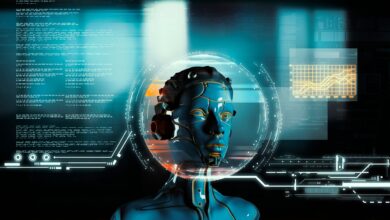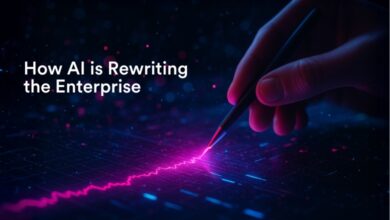Artificial intelligence is moving at lightning-fast pace – shifting from something that quietly powered back-office systems, to a force that’s now reshaping the way we work. Tools like ChatGPT have shown just how far generative AI has come, with the ability to understand and create language in ways that are changing how we write and communicate in the workplace.
But the next frontier for enterprise AI isn’t just about producing content -it’s about taking action. Agentic AI represents a new class of intelligent systems that operate autonomously, continuously, and at scale, helping to eliminate business disruption and unlock productivity across the workforce. Rather than passively assisting, agentic AI executes on behalf of users, applying real-time intelligence to meet complex organisational needs.
This marks a shift in how organisations apply technology to workforce transformation – from a world of talent intelligence to one of talent advantage.
Turning Talent Intelligence into Competitive Advantage
The concept of talent intelligence helped employers better understand the skills, experience, and potential of their people. But in an era defined by continuous change, understanding is no longer enough. HR leaders now need systems that act, not just analyse.
This is the foundation of the shift to talent advantage. It’s a transition from static, siloed systems to intelligence-driven experiences that anticipate workforce needs, close skills gaps, and deliver real-time, actionable productivity. With agentic AI, organisations move beyond decision support to platforms that engage, orchestrate, and optimise work across the entire talent lifecycle.
This is not a marginal gain. It’s a reimagining of how companies hire, develop, and retain talent to stay competitive in a rapidly evolving economy.
What agentic AI really means for business
Agentic AI refers to intelligent systems that can independently act on behalf of users, within an ethical and operational boundary. These agents don’t just suggest, they do. Whether applying for roles, recommending internal moves, or engaging with candidates autonomously, agentic AI brings a level of purposeful autonomy that transforms how work gets done.
It represents a leap forward from traditional automation. Where automation follows rules, agentic AI interprets context. It continuously learns, adapts, and executes, based on enterprise data, evolving goals, and user feedback.
This makes agentic AI uniquely suited to complex, people-centric functions like hiring, development, and workforce planning. Areas where decisions are nuanced, and context is everything.
Digital Twin Technology: Unlocking the Hidden Value of Work
A critical breakthrough powering agentic AI is the Eightfold Digital Twin, a personalised large language model that integrates across enterprise systems to capture the full context of an employee’s work. This includes not only their skills and experience, but the decisions they’ve made, the relationships they’ve built, and the contributions they’ve delivered across platforms such as email, Slack, CRMs, and project tools.
By surfacing this deep, often hidden, knowledge, organisations can finally move beyond static profiles to dynamic, always-evolving insights. Digital Twin technology empowers HR leaders with a continuous understanding of their workforce, treating people not just as roles or job titles – but as engines of creativity, collaboration, and growth.
This shift enables smarter succession planning, more personalised learning pathways, and a deeper culture of knowledge sharing.
Smarter Hiring Starts Here: How AI Interviewers Are Closing the Talent Gap
In talent acquisition, agentic AI is redefining the way candidates interact with employers. Using tools such as an AI Interviewer Agent engages candidates dynamically and conversationally, autonomously assessing their capabilities and potential around the clock and completing the critical last mile between sourcing and hiring.
By meeting candidates where they are, when they are free to engage, this 24/7 interviewing agent improves responsiveness, enhances candidate experience, and increases selection quality. It eliminates lag and manual effort, while ensuring every interaction is aligned with the employer’s brand and values.
This isn’t just about automation – it’s about building more intelligent, human-centric candidate journeys through continuous, contextual engagement.
“When it come to recruitment, the goal of agentic AI is not to replace people but to automate 80% of your workload—handling the repetitive, time-consuming work while keeping the critical 20% in your hands. This should free up time for higher-value tasks like complex decision-making and final candidate selection.” Vineet Abraham, Eightfold AI
Autonomy Over Automation
While automation has delivered operational gains for HR, its limitations are becoming clearer. Automation is rule-based and reactive. Agentic AI, by contrast, is contextual and proactive. It can understand ambiguity, learn from feedback, and act independently to support evolving workforce needs.
This autonomy matters in HR, where decisions are rarely binary. Whether recommending career development steps, surfacing team performance insights, or orchestrating cross-functional talent moves, agentic AI enables organisations to adapt in real time, supporting agility without adding administrative burden.
The result is a more empowered HR function, capable of delivering impact at speed and scale.
Trust, transparency, and responsible design
With greater autonomy comes greater responsibility. As AI begins to act more independently, it must be designed with strong ethical guardrails. Agentic systems should be transparent in how they make decisions, provide opt-out mechanisms, and ensure users retain control.
Employees and leaders alike must understand what data is being used, how their digital twin operates, and how to challenge or refine recommendations. Consent, explainability, and accountability must be built into every layer of the system.
Trust is the foundation of any technology that touches the workforce. Without it, even the smartest AI will fail to deliver meaningful change.
The future of work is action-driven
In this new landscape, businesses no longer want dashboards that report on what happened – they want systems that know what to do next. Agentic AI delivers on that promise by making data operational. It turns passive signals into proactive action.
Whether it’s suggesting a better-fit role, identifying future leaders, or accelerating onboarding through contextual knowledge, agentic AI enables HR leaders to shift from reaction to strategy. It unlocks workforce productivity in real time, not as a report, but as a living system that acts.
Conclusion: Next Chapter of Human Potential
Agentic AI is not a trend, but a turning point. By capturing the full context of work, activating talent data, and taking purposeful action, agentic AI empowers organisations to redefine productivity, not in terms of outputs, but in business outcomes.
This isn’t about replacing HR, it’s about elevating it. With agentic systems working in concert with human leaders, the workforce becomes more adaptive, self-improving, and future-ready.
As my colleague and fellow co-CEO and co-founder of the company, Ashutosh Garg says: “The future of work is not about people vs. machines — it is about people and intelligent agents working together… The future of work is here.”





